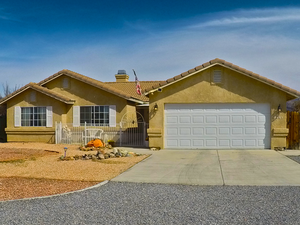Refinancing can be a very effective way to save money -- just be sure to go about the process in an informed manner, making sound choices along the way. These seven tips can help.
Interest rates are starting to inch up, with many expecting the Fed to raise rates a little more later this month. A recent strong jobs report is only making that more likely. If you have thought about refinancing your mortgage, you might want to think hard about it now, and perhaps lock in a low rate if you're serious.
Refinancing is taking on a new home loan to pay off your old home loan. The new mortgage can have different features, such as a longer or shorter term, and it can lower your monthly payments, too.
Beef up your credit score
Before you start talking with lenders about refinancing your mortgage, make sure your credit score is strong -- and if it's not, spend some time looking into how you might raise your score, such as by correcting errors in your credit report, paying down debt, and paying bills on time. The table below shows what kind of difference a strong score can make. It reflects recent interest rates for someone borrowing $200,000 via a 30-year fixed-rate mortgage and makes clear how much you might save by boosting your score.
|
FICO Score |
APR |
Monthly Payment |
Total Interest Paid |
|---|---|---|---|
|
760-850 |
4.022% |
$957 |
$144,653 |
|
700-759 |
4.244% |
$983 |
$153,944 |
|
680-699 |
4.421% |
$1,004 |
$161,442 |
|
660-679 |
4.635% |
$1,029 |
$170,611 |
|
640-659 |
5.065% |
$1,082 |
$189,377 |
|
620-639 |
5.611% |
$1,105 |
$213,836 |
SOURCE: MYFICO.COM, AS OF MID-MARCH 2017.
Compare APRs, not APYs
When shopping around and comparing mortgage interest rates, be sure to pay more attention to quoted annual percentage rates (APRs) than annual percentage yields (APYs). The APY will indeed reflect a loan's interest rate, but the APR will more accurately reflect what you'll be paying -- because it incorporates expenses such as closing costs.
Pick the right length
When considering what kind of new mortgage to take on to replace your old one, think about how long you want your mortgage to last. Most people take on 30-year loans, and most people know about 15-year loans, which generally feature significantly higher payments and lower rates -- but know that those are not the only options. There are 20-year mortgages, too, which offer a nice compromise between the 15- and 30-year loans. And there are even 40-year mortgages, as well as other lengths. Your best bet is to figure out how much you can comfortably afford in monthly mortgage payments and then get the shortest-term loan that matches up with that.
Pay more
As you go through the process of getting pre-approved and approved for your new loan, make sure it won't penalize you for making prepayments against your principal. Why? Well, because you can save gobs of money by paying more than you have to each month -- or each quarter, each year, or just occasionally. The table below shows just how much someone might save by making various kinds of monthly prepayments. It assumes a 30-year $200,000 fixed-rate mortgage taken out at an interest rate of 4.5%. The regular monthly payment would be $1,013.38.
|
Payment Method |
Pay Off Loan In... |
Total Interest Paid |
Total Interest Saved |
|---|---|---|---|
|
Minimum payment |
30 years |
$164,810 |
$0 |
|
$100 extra monthly |
25 years |
$133,066 |
$31,744 |
|
$200 extra monthly |
21 years and 6 months |
$112,056 |
$52,753 |
|
$500 extra monthly |
15 years and 3 months |
$76,698 |
$88,111 |
|
$1,000 extra monthly |
10 years and 5 months |
$50,679 |
$114,131 |
SOURCE: AUTHOR CALCULATIONS AT MTGPROFESSOR.COM.
Don't fall for "no-cost" refinancings
There are always costs. Refinancings, like original mortgages, have closing costs -- and you'll either pay them upfront or they'll be conveniently tacked onto your loan amount -- which can increase your interest rate. It's usually best to pay the costs upfront. (If you're not planning to stay in the home long, though, it can be worth folding the closing costs into the loan, as you won't be dealing with the higher interest rate for too long.)
Consider paying "points"
You may be able to lower your interest rate (and thus the amount you'll pay in interest over the life of the loan) by paying "points." A point is equal to one percentage of your loan value. So if you're borrowing $200,000, a point would be $2,000. You can often reduce your loan's interest rate by about 0.25% or so per point paid. This can be well worth it -- as long as you expect to be in the home long enough to break even. If you're saving $40 per month by paying a $2,000 point, dividend $2,000 by $40 and you'll get 50, meaning that it will take 50 months before you break even.
Don't take cash out
Many people refinance to cash out some of their home equity, but it's generally best not to do so. As an example, imagine that your home is worth about $300,000. If you currently owe $150,000 on it and have $150,000 in home equity, you might refinance into a new $200,000 loan, keeping about $50,000 in cash. The cash is nice -- and with current low interest rates it's an inexpensive way to borrow money -- but you've now set yourself up with a bigger mortgage and you have less home equity. Think carefully about whether it's worth it. If you're going to use the cash to pay off high-interest rate credit card debt, for example, that's a smart money move. Know, too, that cash-out refinancings can carry higher interest rates than ones without cash-outs.
Refinancing can be a very effective way to save money -- just be sure to go about the process in an informed manner, making sound choices along the way.
by Selena Maranjian
Mar 14, 2017 at 6:23AM
https://www.fool.com/mortgages/2017/03/14/7-tricks-to-use-when-refinancing-a-mortgage.aspx
Mastura Roberts
(702) 919-5400
offers@greatlasvegashomes.com
Team Leader, The Tonnesen Team
Berkshire Hathaway HomeServices, Nevada
3185 St Rose Pkwy #100 Henderson, NV 89052
With over 30 years of experience helping families call Las Vegas "home!"
Related Blog Posts
BLOG NAVIGATION
ARCHIVES
- December 2022
- November 2022
- October 2022
- September 2022
- August 2022
- July 2022
- June 2022
- May 2022
- April 2022
- February 2022
- January 2022
- December 2021
- November 2021
- October 2021
- September 2021
- August 2021
- July 2021
- June 2021
- May 2021
- April 2021
- March 2020
- February 2020
- January 2020
- November 2019
- October 2019
- September 2019
- August 2019
- June 2019
- May 2019
- April 2019
- March 2019
- February 2019
- January 2019
- December 2018
- November 2018
- October 2018
- September 2018
- August 2018
- July 2018
- April 2018
- January 2018
- December 2017
- November 2017
- October 2017
- September 2017
- August 2017
- July 2017
- June 2017
- May 2017
- April 2017
- March 2017
- February 2017
- January 2017
- October 2016
- September 2016
- August 2016
- September 2014
- June 2014
- May 2014
- April 2014
- March 2014
- February 2014
- January 2014
- December 2013
- October 2013
- September 2013
- August 2013
- June 2013
- May 2013
- April 2013
- March 2013
- February 2013
- January 2013
- December 2012
- November 2012
- October 2012
- September 2012
- August 2012
- July 2012
- June 2012
- May 2012
- April 2012
- March 2012
- January 2012
- December 2011
- November 2011
- October 2011
- September 2011
- August 2011
- July 2011






